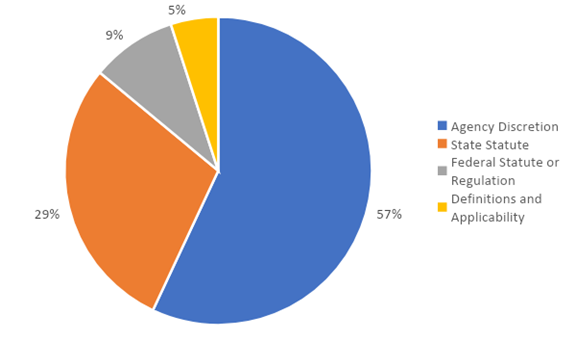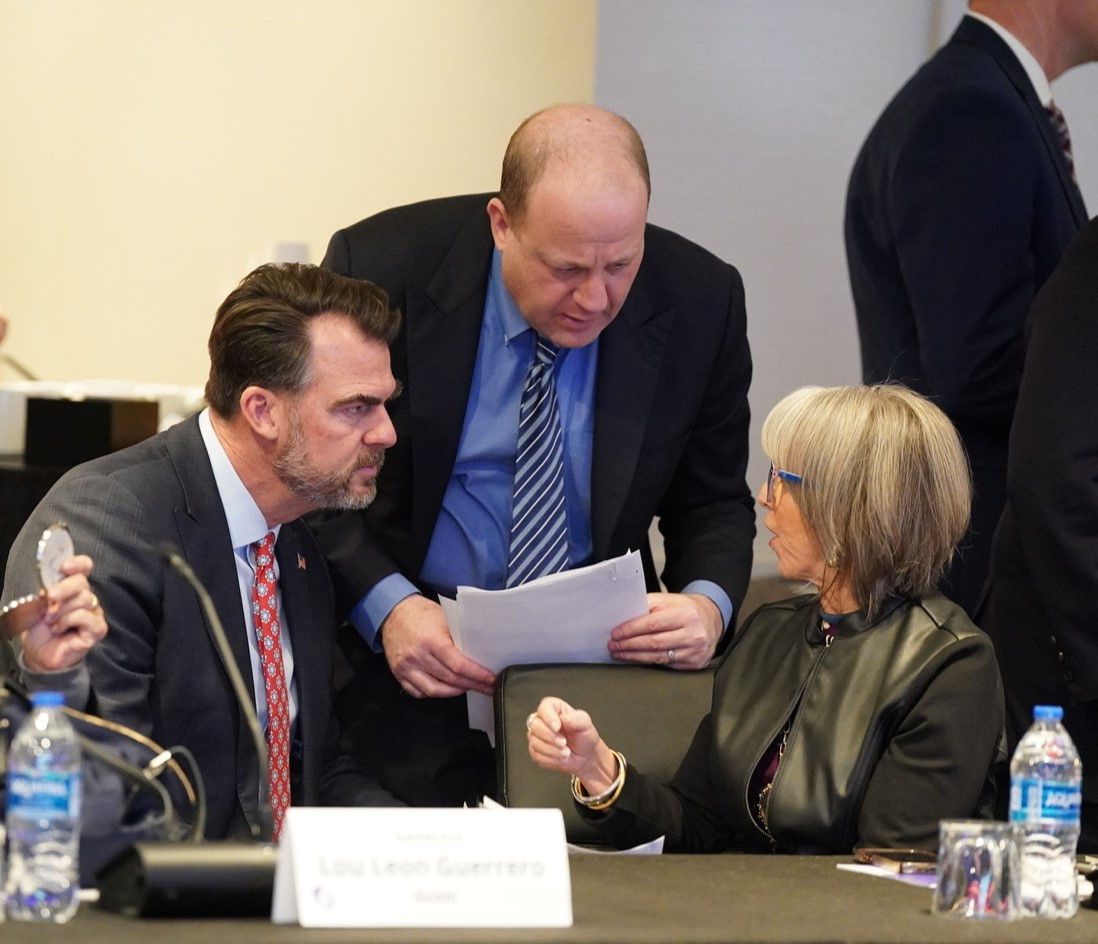A growing number of states are making significant headway towards creating better regulatory management systems and leaner regulations. This will undoubtedly save on administrative costs, eliminate redundancies and provide lessons that can improve efforts for reviewing and cataloging regulations in the future.
(Download)
Executive Summary
Well-designed regulations protect workers, consumers and the environment, while promoting entrepreneurship and economic growth. However, regulations also become outdated, and processes can become cumbersome and hinder business compliance. Thus, the way in which a state implements its regulations can be a major problem for business formation, economic growth and opportunity.
This report highlights state efforts to streamline regulatory systems and processes. If implemented carefully, these practices have the potential to help states reduce compliance burdens on businesses and improve the delivery of policies to state residents, including ensuring clear communication of those policies. States are finding innovative ways to make public interactions with the government more user-friendly with efforts aiming to save businesses time and money and thereby helping contribute to economic growth.
The report is structured around specific state strategies that can be applied when reviewing regulations:
- Creating inventories to catalog rules
- Setting goals and committing to transparency
- Applying measurement techniques
- Analyzing and assessing regulations
- Practicing outreach and marketing
- Reporting to the Governor
- Putting into place oversight and enforcement mechanisms
- Ensuring sustainability of reforms
Notably, reform efforts have been decidedly bipartisan. A diverse group of states, including Colorado, Idaho, Kentucky and Rhode Island have engaged in regulatory streamlining exercises in recent years. Additional states showcased in this report include Arizona, Missouri, New Jersey and Ohio.
This report concludes that regulatory streamlining efforts can assist with the swift and effective delivery of policies from government to businesses and citizens, thereby ensuring rules and regulations are easier to follow and less burdensome to comply with.
Introduction
In recent years, states have explored ways to produce a leaner, more responsive state government. This movement has centered around improving the systems and processes that deliver policies in the states, especially with respect to how ordinary citizens and businesses interact with government regulations.
This report reviews efforts in the states to streamline regulatory systems, thereby reducing compliance burdens on businesses and improving the delivery of policies to state residents. The report is structured around the following state strategies for reviewing regulations: creating inventories to catalog rules, setting goals and committing to transparency, applying measurement techniques, analyzing and assessing regulations, practicing outreach and marketing, reporting to the Governor, putting into place oversight and enforcement mechanisms, and ensuring sustainability of reforms.
The regulatory reviews discussed here are varied in their structure. For example, some state initiatives were cleverly marketed, while other efforts were less conspicuous. Some had public-facing websites and catchy names, while others focused on producing reports primarily for internal government use. In each of the areas discussed below, states have taken innovative and often distinct approaches, which can offer lessons for other states looking to improve their own residents’ experiences when interacting with their state government.
Creating Inventories to Catalog Rules
Regulators can have hundreds, or even thousands, of rules under their authority. Creating an inventory of rules and requirements is a way to make the daunting task of reviewing regulations more manageable. Arizona provides an instructive example. Under Arizona law, state agencies must conduct a review of administrative rules every five years. While this periodic review process is an ongoing feature of regulating in Arizona, the administration of Governor Doug Ducey looked for ways to weave this periodic review process into a broader regulatory improvement effort known as the “Regulation Rollback” initiative. The Governor’s Regulatory Review Council (GRRC) provided a template that agencies were obliged to complete for every existing regulation. The template asked for information about each rule, including:
- The authorization for the rule
- The objective of the rule
- If the rule was achieving intended objectives
- Whether the rule is consistent with other rules and statutes
- The extent to which the rule is enforced
- Whether the rule is clear and understandable
The amount of discretion an agency holds can vary substantially from rule to rule. This information is important to collect because when an agency has discretion over a particular regulation, the agency can update the regulation to reflect changing circumstances more easily than when regulations are required under state or federal law. In Arizona, agencies identified one of the following four potential sources of original authority for each regulation: 1) agency discretion, 2) state statute, 3) federal statute and regulation or 4) definitions or applicability.
Arizona provides an overview of this information for every regulation via an easy-to-navigate website from the Office of Economic Opportunity (OEO).[i] This website includes other statistics as well, such as a total number of rules, the change in rules year-over-year, the total number of words in the Arizona Administrative Code, the number of restrictive words,[ii] the count of rule revisions by year and a count of rule revision savings.
According to a recent rule inventory, Arizona agencies had 11,222 rules in place. In total, 57% were classified as discretionary (6,354), 29% were required by state statute (3,224), 9% were classified as required by federal laws or regulations (977) and 5% related to definitions or applicability (667). See Figure 1.
Figure 1: Original Authority for Arizona State Regulations

The OEO website also has annual reports that summarize the number of regulations amended each year, along with corresponding savings associated with those improvements. For example, a 2020 report notes that 462 rules were improved or eliminated across 26 state agencies that year; OEO estimated the changes led to annual productivity gains worth $14.7 million. Much of these gains came from reducing the impact of Department of Health Services regulations on the education and health services sectors. The aggregate statistics are further broken down by industry and agency and also aggregated across time. The report notes that “This may also seem insignificant in a state with real GDP of $325 billion (chained 2012 dollars) in Q3 2020, but these annual losses become cumulative over multiple years. Even modest gains in GDP can multiply into immense gains over large time horizons, such as $218 million over ten years.”
In addition to inventorying rules on a periodic basis, such as in Arizona, some states are beginning to set up a regulatory budgeting infrastructure. Analogous to agencies being allocated a certain amount of annual spending authority, regulatory budgeting allocates to agencies a certain amount of rulemaking authority for a specific time period.
Arizona has demonstrated that creating an inventory of rules and requirements is a way to make the daunting task of reviewing thousands of regulations more manageable. When creating an inventory, certain information should be captured, including where the original authority for particular rules comes from and whether the agency has discretion to amend a rule on its own or whether legislative changes are needed instead.
Setting Goals and Committing to Transparency
Governors and their administrations should be clear about what their reforms are aiming to accomplish. This can be achieved by communicating explicit goals for the reforms, as well as through transparent data releases and public reporting about how regulations are being amended as part of reviews. In 2016, Kentucky Governor Matt Bevin launched a regulatory review effort that lasted throughout his term in office. Governor Bevin’s streamlining initiative was named the “Red Tape Reduction Initiative,” for which a website was created where individuals could report regulations that were “outdated, unnecessary or overly complex.” The website noted that the reform drew inspiration from the experiences of the Canadian province of British Columbia, which underwent a significant regulatory review effort in the early 2000s. Governor Bevin set a 30% reduction goal for state regulations, which was similar to British Columbia’s goal of reducing regulations by one-third within three years. Reduction goals can improve businesses’ efforts to navigate a complex regulatory environment. Fewer rules that are clearer in their instructions means less complexity. This often benefits small businesses since they lack the resources that large businesses often have to devote to compliance activities.
The Kentucky regulatory initiative was especially notable for its transparency. The state produced an online inventory of rules that enabled the public to track changes to the regulatory code as they were made. Rule inventories are accessible through internet archives. The website claimed the administration amended 693 regulations and repealed 628 which, together, represented approximately 28% of the 4,700 state regulations in force at the time. The website hosted spreadsheets listing every regulation amended or repealed as part of the review. For each regulatory action, the related spreadsheets provided a legal citation to the rule in the code, the relevant department or office, a link to the regulation where applicable and a citation to the regulation amending or repealing the original rule as well as the date when the Administrative Regulation Review Subcommittee had reviewed (or would be reviewing) the regulation.
Applying Measurement Techniques
States have used a variety of metrics to gauge whether regulatory reforms are achieving their goals. These include reduced wait times for permits, hours spent filling out paperwork, counts of complaints and money saved for consumers or businesses. The unit of measurement could also be a count of rules, pages or chapters. Another useful metric compares changes in the number of regulations issued each year. The State of Rhode Island underwent a number of significant regulatory changes throughout the administration of Governor Gina Raimondo. A 2015 executive order required regulatory agencies to produce a cost-benefit analysis alongside their rules and to submit those rules and analysis to the Office of Regulatory Reform (ORR) for review. Governor Raimondo also signed a law in 2016 updating the state’s Administrative Procedure Act. At that time, Rhode Island was one of only two states that did not have a consolidated administrative code. The 2016 legislation put a sunset provision on the administrative rules currently in place so that rules would have to be refiled in order to be codified into a uniform state code by January 1, 2019. Any rules that were not refiled would expire.
ORR oversaw the reform effort, focusing on four areas:
- Removing outdated and onerous requirements
- Increasing transparency and clarity of requirements
- Leveraging national best practices and
- Aligning statute, regulation and implementation.
Governor Raimondo also set a 15% reduction goal for the state’s regulatory volume.
To prepare for the impending deadline, ORR staff:
- met with agency rules coordinators to develop plans in anticipation of the 2019 sunset,
- advised agencies on new cost-benefit analysis requirements, and
- trained over 100 agency staff on how to draft clear regulations and evaluate economic impacts.
A 2019 report from ORR notes that at the outset of the reform initiative, there were 1,387 active executive branch agency regulations, spanning a volume of 25,842 pages.
According to the report, 467 rules were amended, 433 were consolidated (into 134), 327 were codified without changes and 160 were repealed. This means agencies revised or eliminated 77% of regulations on issues ranging from notary requirements to underground storage tank rules.
In its various reporting, ORR included a number of specific examples of regulations that were simplified in order to make compliance with the regulations easier. For example:
- Motor vehicle tax regulations from the state Division of Taxation were consolidated from sixteen regulations into a single regulation.
- The Rhode Island Department of Health was able to cut the length of the implementation plan for its Special Supplemental Nutrition for Women, Infants and Children (WIC) Program from 672 to 29 pages.[iv]
Additionally, ORR noted that relative to the 10 years prior to the 2015 executive order, there was a 199% increase in regulatory consolidations or repeals, a 61% decrease in emergency regulatory actions and a 43% decrease in regulatory actions involving adoptions and amendments.
Rhode Island is an example of a state that captured appropriate metrics and used them to both summarize what was being reviewed and what was being changed as a result of reforms. The unit of measurement could be a count of rules, pages, chapters, requirements, word counts or more sophisticated proxies for regulatory burden like cost estimates. States have also found that wait times, hours spent filling out paperwork, numbers of complaints and cost savings are also ways to measure burdens. Whatever metric is chosen, it should help agencies tackle the complex task of managing a large body of rules and assist the Governor in effectively communicating the results of reforms.
Analyzing and Assessing Regulations
Economic analysis can guide regulatory review efforts and help state administrations prioritize which regulations should be amended and which discarded. In 2019, Idaho underwent a major regulatory overhaul when the state legislature ended its annual session without passing a reauthorization bill for the administrative code. Such a bill is required in Idaho due to an annual sunset provision embedded in state law. Governor Brad Little and his team took the opportunity to rewrite the administrative code in a more streamlined and easy-to-understand manner given the unusual set of circumstances.
Even before the sunset of the administrative code, Governor Little’s administration was prioritizing regulatory reform. One of Governor Little’s first actions upon taking office was to sign an executive order dubbed the Red Tape Reduction Act. The executive order required agencies to conduct a review of their regulations. The review effort was overseen by the Division of Financial Management (DFM), which is Idaho’s equivalent of a budget department. As part of the review, various metrics were tracked including page, chapter and regulation counts, which can be viewed as rough proxies for cost or burden when more sophisticated analysis is unavailable or impractical.
In early 2020, Governor Little issued a second regulatory executive order which superseded the Red Tape Reduction Act order of 2019. This new order imposed a moratorium on new rulemaking, with some limited exceptions for rules intended to prevent well-documented public health threats or reduce regulatory inefficiencies. A key benefit of a moratorium is it enables more gubernatorial control, and hence oversight, over administrative agencies, since essentially every regulation issued must receive special approval from the Governor or a designee before it can be enacted.
Several regulatory management processes were adopted during the Little Administration. First, the Little Administration amended an Administrative Rules Review Form (ARRF), a document which must be included with proposed rules, to require more information from agencies. The ARRF must include a summary of the rule, the projected fiscal impact and the impact on state competitiveness. Moreover, a typical ARRF must be signed by a DFM analyst, someone from the Governor’s office and the DFM administrator. Another innovation from Idaho is a requirement that proposed rules have an official letter signed by the agency director explaining the need for the rule.
The Little Administration also required a new prospective analysis form be included with all proposed regulations. This form asks the agency to define the problem the proposed rule is supposed to solve, identify whether the problem can be addressed by non-regulatory measures and compare the proposed regulation to similar rules in other states. These forms were also used to track and manage the volume of regulatory language added or subtracted by an agency.
Governor Little’s 2020 executive order also set up a 5-year review process. Consequently, roughly 20% of each agency’s chapters are up for review annually. As part of this process, an agency must first repeal the chapter in question and then reintroduce the chapters through a new rulemaking if the rules are to be carried forward for another 5-year period. Idaho agencies are encouraged to defer regulatory updates until the particular chapter in which the rule is codified is up for review under the 5-year process. Conversations with Idaho officials revealed that agencies often conflate rulemaking output with agency productivity. Putting regulations on a time schedule whereby they can only be updated during fixed windows is a creative way to address this problem. As noted above, exceptions are available if there is a well-documented public health threat or if a regulation is intended to reduce regulatory inefficiencies. In our conversations with Idaho officials, we learned about some of the most successful changes made to state regulations. The Department of Labor lifted some requirements on the processing of unemployment insurance claims in order to deal with the rapid increase in claims due to the COVID-19 pandemic. And the state streamlined requirements for those seeking state grant funding. For example, many agencies had rules in place that outlined grant application requirements. Frequently, these were moved to supplementary websites outside the direct language of rules, which gave agencies flexibility to change the terms of applications such as deadlines without the need to reopen and amend their regulations.
Producing an economic analysis for every regulation evaluated as part of a review can be impractical, but a number of states incorporate analysis into their reviews in some way.
Idaho found success by requiring agencies to repeal their existing regulatory chapters periodically and then requiring agencies to analyze them prior to being reintroduced and recodified.
In Rhode Island, a new executive order required economic analysis and review of regulations by the state budget department.
Practicing Outreach and Marketing
Communicating the benefits of reform is important so that the public understands what is at stake and how an easier-to-navigate regulatory system benefits them. Clear communication also helps the public see what an administration is accomplishing. Missouri began a regulatory review effort in 2017 under the leadership of Governor Eric Greitens. The effort started with the issuance of an executive order requiring regulatory agencies to conduct a review of their regulations and produce a report based on the findings. Specific individuals within the agencies were designated to be point persons for the regulatory review, and a website was built where businesses or other members of the public could identify a regulation for review, provide examples of agencies impacting them or describe actions they believed the administration should take. As part of the initiative, the administration hosted public meetings around the state that were open to the general public as well as industry and advocacy groups. For example, agency representatives set up tables at the Missouri State Fair to speak with state residents directly and conducted outreach via social media and the press to solicit comments from the public.
Each agency was asked to solicit a minimum of 100 comments. While some smaller agencies did not hit the 100-comment target, most agencies did, and the shortfalls at smaller departments were made up for by other departments. For example, the Missouri Department of Agriculture solicited more than 2,000 comments, and the state’s Department of Conservation solicited almost 1,000. Altogether, Missouri received 5,765 public comments as part of its campaign. A 2019 survey of six regulatory review efforts in states found that regulatory reviews usually yield a few hundred comments. This Missouri initiative yielded roughly ten times the average number of comments reported by this survey.
Many Governors have found that regulatory streamlining can be a pillar of their policy platform that helps to define their Governorship. Initiating a regulatory streamlining reform sends a clear signal to the public that a Governor is taking the economy and business climate seriously. The benefits of reforms are often communicated to the public through the creation of online websites which, among other things, allow members of the public to submit information about regulations that are giving them problems, as was done in Missouri.
Reporting to the Governor
Regular reporting can ensure that lessons from regulatory reviews are communicated to the right decision-makers so that appropriate actions can be taken based on gathered information. Colorado Governor John Hickenlooper’s two terms in office came to be partly defined by a regulatory improvement initiative. A series of roundtable discussions were held around Colorado in 2011, labeled the “Pits and Peeves Roundtable Initiative.” The purpose of the discussions was to create a forum for members of the government to solicit feedback from businesses and other community members about their experiences dealing with the government as well as any problems they may routinely encounter.
An outgrowth of these initial conversations was a regulatory streamlining effort known as the “Pits and Peeves Initiative.” The reform built on broader themes of the Hickenlooper Administration as embodied in two executive orders related to improving government efficiency. Issued in 2011 and 2012 respectively, the first executive order related to developing a customer service approach to government, and the second executive order mandated a review of agency rules to ascertain whether they were easy to understand or could be amended to reduce burdens while maintaining their benefits, among other factors.
When regulations were updated, a myriad of statistics were recorded in many cases, including the number of customers impacted by the regulation and the total savings in terms of time and money from amendments to the regulation. This information was published in a series of reports as well as on a performance scorecard. In total, three reports were issued as part of the initiative: one in late 2011 that described the initiative in its first year, a supplemental report in 2013 and a 2014 report with information about progress to that point.
According to a November 2017 update, between 2011 and November of 2017, 92% of Colorado agencies’ rules were reviewed. This constituted over 24,000 rules, of which more than 6,500 were modified and 4,500 repealed as part of the review process. Efforts in 2017 were estimated to have resulted in annual savings worth $7.8 million with 2,260,000 hours of saved time. As in Arizona, the cost savings may seem modest relative to the size of the Colorado economy, nevertheless these savings could accumulate over time through compounding reinvestment.
These savings came from a variety of improvements ranging from eliminating redundant securities paperwork to streamlining the licensing process for engineers. Agencies also focused on leveraging improved technology, for example by moving forms and reporting online and prioritizing enforcement based on risk.
Examples of specific actions taken by Colorado agencies over the entire time frame included:
- A Department of Human Services (DHS) action saved child care providers time spent on applications by enabling online submission of licensing applications and payment of fees with a credit card. The action saved 96 hours per child care provider or 2,112,000 million hours total.
- The Colorado Department of Local affairs eliminated 56 of 103 forms required for a federal program that provides rental assistance.
- The Departments of Revenue and Personnel & Administration redesigned the tax document process to save nearly $2.1 million on an ongoing basis.
In Colorado, online submission of licensing applications and payment of fees with a credit card saved 96 hours per child care provider or 2,112,000 million hours total.
Colorado also employed an internal government program called “Lean” throughout Governor Hickenlooper’s time in office. According to one report, “Lean is a powerful process improvement tool that was originally developed in the private sector by the Toyota Production System to eliminate waste in manufacturing.” In 2011, Governor Hickenlooper established the Colorado Lean Program Office. The Lean process could be adopted by any state and works by defining eight wasteful activities commonly found in government including waiting, approvals, silos, transportation, errors, failure to prioritize, underutilized talents and lack of standards. Lean also includes a 5-step solution process. Roughly, these steps include:
- Define the problem to be solved
- Make a plan and engage the right people
- Target solutions based on the root causes of problems
- Test to make sure fixes work
- Make it stick
As Chairman of the National Governors Association, Governor Hickenlooper shared lessons from these experiences with other states interested in pursuing regulatory reforms. The Hickenlooper Administration aimed for a comprehensive overhaul of the way that state government operates. It focused on improving government culture to emphasize customer service, periodic review of agency rules and borrowing best practices from the private sector. Colorado also aimed to leverage more effective use of technology, for example by moving forms and processes online or holding events virtually that previously took place on an in-person basis only.
Reporting is critical to aid a Governor in communicating the results of reforms and for sharing best practices with other states. Colorado produced reports that included statistics such as how many rules were reviewed, financial cost savings and hours saved on compliance, along with information about the substance of rule changes.
Putting into Place Oversight and Enforcement Mechanisms
Some regulators may be resistant to change, so appropriate oversight is needed along with enforcement mechanisms to ensure they carry out the necessary reforms. In 2019, the Ohio legislature passed language in its budget appropriations bill requiring state agencies to conduct a review of their regulations and create inventories of their regulatory restrictions. Rules that include the words “shall,” “must,” “require,” “shall not,” “may not” and “prohibit” are considered to contain regulatory restrictions. Upon signing the legislation, Governor Mike DeWine touted that this action would provide significant regulatory relief for Ohio businesses.
The legislation gave state agencies until the end of that year (2019) to produce a “base inventory” of their restrictions. The state’s Joint Committee on Administrative Rule Review (JCARR) was tasked with collecting each agency’s inventories and transmitting inventory information to legislative leaders. Subsequent legislation also expanded the 2019 legislation in 2022. Under the new law, state agencies are required to reduce their regulatory restrictions by 30% over three years relative to levels identified in baseline catalogs. JCARR is tasked with tracking agencies’ progress, and penalties are imposed on agencies that fail to comply. For example, agencies that miss their targets are subject to a requirement whereby two restrictions must be eliminated for each new one added until the target is met. JCARR also has authority to grant exemptions to agencies that fail to meet their targets if they can provide a justifiable explanation, such as if hitting a reduction target would put the agency at risk of failing to carry out some critical part of its mission.
New Jersey is another state that has had a unique oversight mechanism for its regulatory review process. During the administration of Governor Chris Christie, a Red Tape Review Group and subsequent Commission were created to oversee an agency review of existing regulations.[iv] These entities were populated in a bipartisan fashion with members of both the legislative and executive branches. Regular reporting was issued by the commission throughout Governor Christie’s time in office, and many recommendations in these reports found their way into passed legislation.[v]
Ensuring Sustainability of Reforms
Institutionalizing reforms by codifying them through legislation can help ensure that a Governor’s legacy is felt long after leaving office. In his final state of the state address, Arizona Governor Ducey highlighted that a priority of his administration in its waning days would be to make permanent the regulatory reforms enacted during his administration. He recognized that some of his administration’s initiatives, such as a moratorium on rulemaking used to strengthen executive review of new regulations, and a requirement that three regulations be eliminated for each new rule added would not have the same long-run impact unless formalized into law. Institutionalizing these changes through legislation would give his regulatory agenda a lasting legacy. Shortly after delivering his speech, a bill passed both chambers and was signed into law by the Governor, codifying these aspects of Governor Ducey’s reforms into statute.
During the COVID-19 public health crisis, in Missouri, Governor Mike Parson’s administration took steps to alleviate statutory and administrative hurdles impeding business transactions in the state. Governor Parson issued executive orders waiving more than 600 state regulations and statutes to provide immediate relief under the rapidly changing circumstances of the pandemic. Some common waivers included allowing meetings and face-to-face requirements to be conducted remotely, allowing electronic notary and notary of paper documents through the use of videoconferencing or other virtual technologies and streamlining licensing processes for healthcare providers. Following the state of emergency, the Parson Administration worked with legislators, state agencies and stakeholders to make several of the waivers permanent, providing longer term relief for businesses and professionals in the state.
In many cases, reforms discussed in this report were initiated via executive order or another form of executive action. Such reforms can be impactful but not always long lasting. Arizona is a state where the Governor has signaled a clear intent to make reforms permanent through legislative changes. Codifying reforms through legislation has the potential to ensure a Governor’s legacy on regulatory improvement lasts far beyond his or her time in office.
Conclusion
As discussed in this report, a growing number of states are making significant headway towards creating better regulatory management systems and leaner regulations. This will undoubtedly save on administrative costs, eliminate redundancies and provide lessons that can improve efforts for reviewing and cataloging regulations in the future. Strategies noted in the report include:
- Creating inventories to catalog rules
- Setting goals and committing to transparency
- Applying measurement techniques
- Analyzing and assessing regulations
- Practicing outreach and marketing
- Reporting to the Governor
- Putting into place oversight and enforcement mechanisms
- Ensuring sustainability of reforms
Governors in other states can learn from these practices and may want to consider implementing similar reviews and related strategies in their own states.
Prepared by James Broughel, PhD, of 4 Score Economics and George Mason University, and Professor Dustin Chambers of Salisbury University, for submission under contract with the National Governors Association Center for Best Practices, June 2022.













